Sunny Garden Days
Giant sunflower, being a late bloomer, brightens our columnist’s garden landscape as autumn arrives.
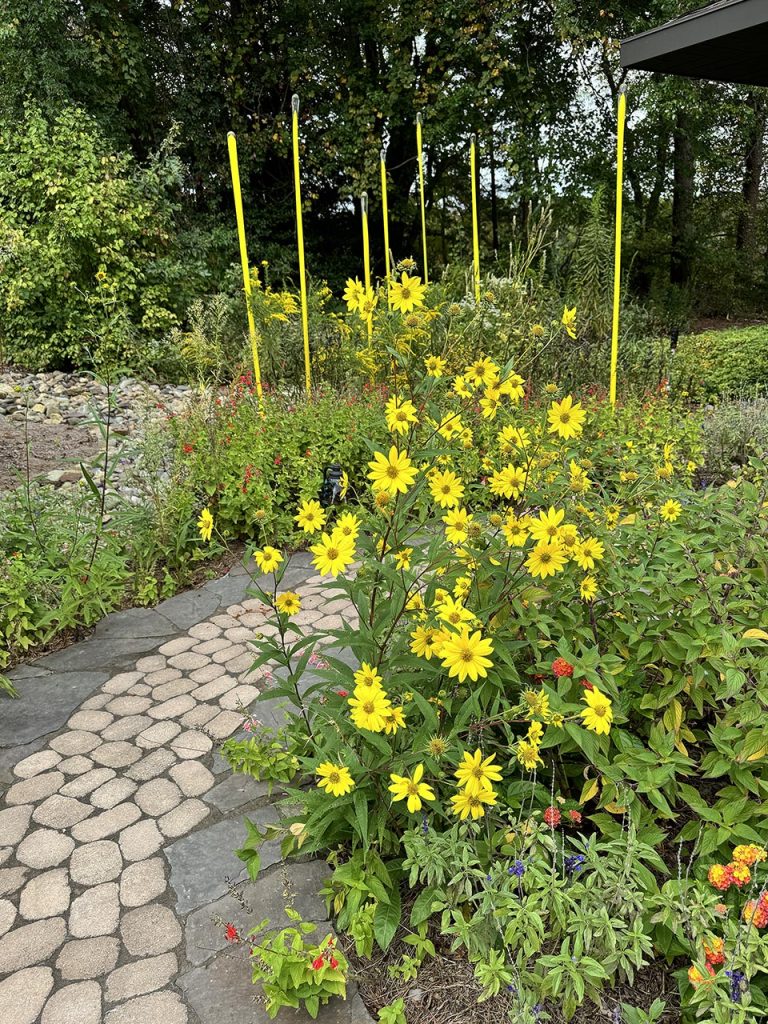
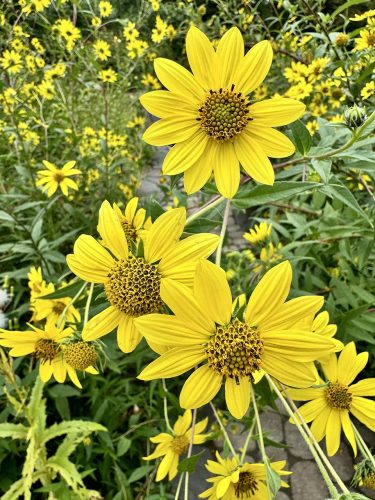
It’s really grand to have some late bloomers in the garden. At this point my zinnias are covered in powdery mildew and our rudbeckia is turning from brown to black. The Mexican sunflowers are in a mixed state of “look at me” and “blindfold, please!”
Now that the heat has dissipated a few flowers get a second wind and will rebound, like Ladies in Red (Salvia spp.), pineapple sage, and super petunias. Regrettably, none of these are natives, but nevertheless add a nice splash of color to the landscape. Thankfully, there are some native fall beauties just coming into bloom, like asters, boneset, blue mistflower, goldenrod, groundsel bush, and the show-stealing helianthus family—our subject species being Helianthus giganteus. (Permit me to remind readers that goldenrod is not an allergen; its pollen is transported by insects only, and it is a super pollinator supporter, with 26 to 30 species found in New Jersey (sources vary).
The helianthus family gets its name from the Greek words helios for ‘sun’ and anthos for ‘flower.’ Giganteus refers to its height and girth. Helianthus giganteus is commonly known as giant sunflower, tall sunflower, and swamp sunflower. The latter is confusing because Helianthus angustifolius is also known as swamp or narrowleaf sunflower. Giant Sunflower is in the aster family.
Our subject species is not the American or Mammoth Giant Sunflower that is grown in acres of farm fields for oil or bird seed, but rather the native species that has much smaller flowers and is found in diverse and naturalized habitats.
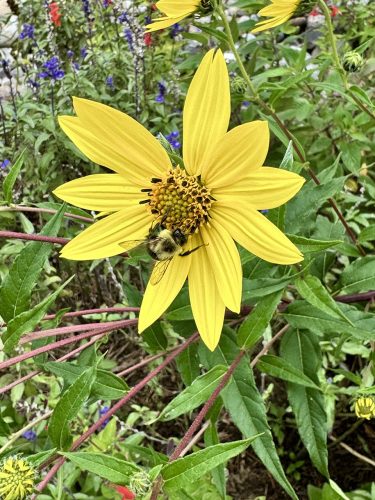
According to the National Sunflower Association, the species was cultivated by American native tribes from about 3,000 B.C. Archeologists believe they were possibly domesticated before corn (Louisiana State University College of Agriculture).
Helianthus giganteus is widely distributed throughout the eastern United States and eastern Canada. It is found in the southern New Jersey area; Karen Williams of Flora for Fauna (a native plant nursery)sees them typically at Cape May Point State Park; Berrytown Road, Port Norris; and the Middle Township bike path.
Preferring full sun and moist soils, Helianthus giganteus is listed by the USDA Natural Resources Conservation Service as a facultative wetland species, meaning it is found in wetland habitats but can also appear in areas that are dry. It is most often seen on wetland edges and in meadows and fields.
We did a “tear out” of our front garden two years ago and enjoyed the splash of color that the giant sunflower offered. It is a perennial that commonly reseeds. No, permit me to correct myself—it profusely reseeds. It also grows by underground stems called rhizomes. Last year it stayed a rather polite two to three feet tall.
This year it exploded all over the garden, much of it at six feet. It makes me wonder if I will ever understand the meaning of sowing a “back border plant.” It has engulfed our garden’s walkway. It has won and it now rules. “Won what?” you ask. Well, everything, including my heart—for now anyway.
The goldfinches who have been eating merrily away at the salvia, zinnia, Mexican sunflower, and rudbeckia seeds for the past six weeks, now are licking their chops (beaks) at the opportunity to feast on this new item. They perch on its wall of yellow, discussing their plan for attack when it goes to seed. By eating these they will further ensure their own brilliant plumage, since it is rich in carotenoids.
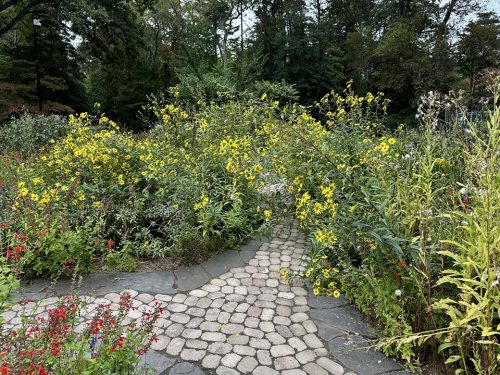
Currently, its stalks quite literally quake with the activity of honeybees, native bees, wasps, butterflies, and beetles. Butterflies and moths whose larvae are known to use sunflowers as a host plant include checkerspots, painted lady, common pug, soybean looper, haploa, giant leopard moth, and border patch.
When the plant emerges in spring it is diminutive, but by August it is starting to give a glimpse of the invasion to come. Many main stalks are pencil-sized but others are like magnum highlighters in circumference, and six feet tall. I’ve read they have the potential to reach heights of 13 feet. All have multiple branching purple stems covered with white hair.
The stems split often and are endowed at the tip with a yellow daisy-like bloom—the “terminal flower.” If you purchase or plant this beauty you’d better like it a lot!
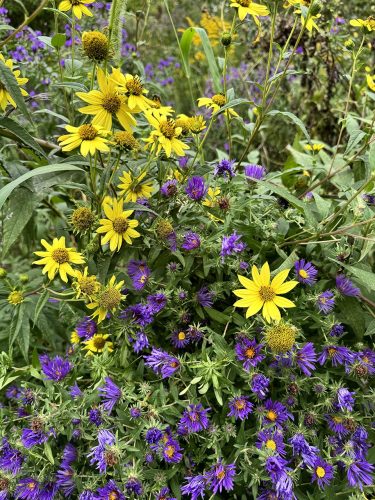
The first week of September the plant let it be known what it was all about, which would be a profusion of blooms 1¾ to 3¼ inches across. Each flower has a center disc surrounded by 12 to 20 brilliant yellow florets/petals. Some of the stalks grow horizontally from the weight of the flowers. Its blooms will persist into this month.
The lance-shaped leaves are opposite on the lower stem and alternate on upper stems. It sprouts both leaves that are shallowly toothed and some that are smooth.
Native American uses included seeds for oil and snacks and milling for flour. It also provided a dye for textiles and paint. Cherokees employed a dry powder made from the plant to induce sneezing. The Choctaw tribe cultivated it for seed and mixed it with corn to make bread. However, the Lady Bird Johnson Wildflower Center warns, “The stems and leaves can cause skin irritation in humans. The plant can be fatal to animals if ingested. Humans should generally avoid ingesting plants that are toxic to animals.”
Late bloomers like the giant sunflower give the garden extended life, and as our hours of light grow shorter they are a bright ray of sunshine to ease the transition into autumn and darker days.
Sources
- Helianthus giganteus, USDA, Natural Resources Conservation Service, Plant guide. Plants.usda.gov.
- Delaware Wildflower Guide, David Smith, Helianthus – the Sunflowers.
- Showy Goldenrod, Wild Plant Culture
- A concise natural history of East and West Florida. B. Romans.
- Lady Bird Johnson Wildflower Center, Helianthus giganteus.
- Minnesota Wildflowers, Environmental and Natural Resources Fund.
- Giant Sunflower, Plants of Eloise Butler Wildflower Garden, the oldest public wildflower garden in the United States, friendsofeloisebutler.org.









